An Italian wedding: Like American weddings but with more romance and … do you have a red suit?
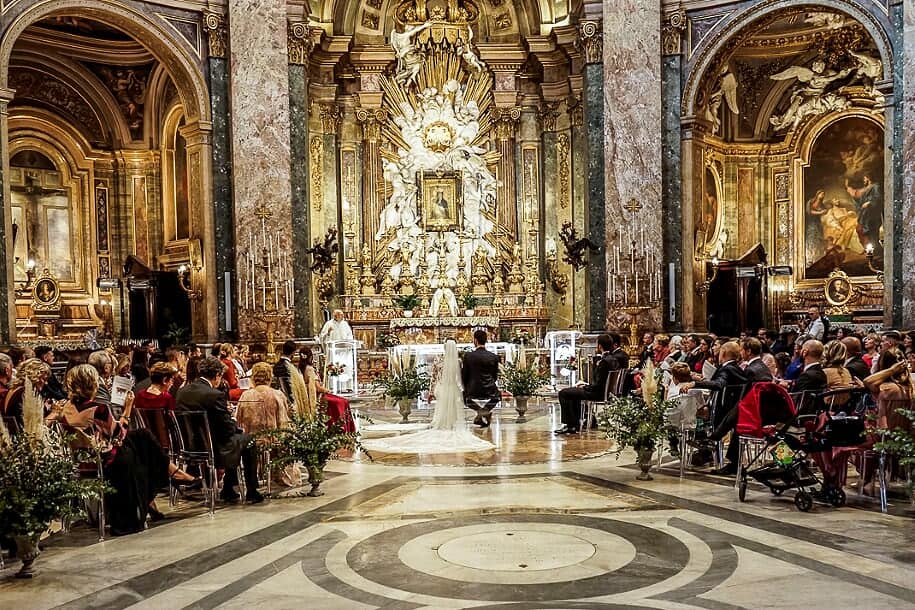
I sipped Prosecco Saturday in the same piazza where Benito Mussolini worked his fascist throng into a froth. I stood in Piazza Venezia, in the shadow of the gargantuan white confectionery monument called Il Vittoriano, in suit and tie, and celebrated the most Italian of Italian traditions.
The Italian wedding.
No, not mine.
It was the daughter of our friends and it was my first. At least, it was my first traditional Italian wedding. In 2002, during my first stint in Rome, I went to a gladiator wedding. True story: I had just graduated from Rome’s gladiator school (Yes, there is one.) and a fellow gladiator, who also had done gladiator reenactments around the city, got married. We all came to the church — dressed as gladiators. Helmets. Axes. Tunics. As they left the church, the couple walked under our raised swords.
It was the first wedding I’ve ever attended wearing a breastplate.
Saturday’s wedding dripped Italy. From the 18th century church lined with paintings to the view of Rome from the 100-year-old villa that hosted the reception, the whole affair was right out of Central Casting. You could have added a violin ensemble and the cast of “The Godfather” as guests and you wouldn’t have noticed.
The typical Italian wedding has a lot of the same traditions as in the U.S. The bride and groom don’t see each other the night before the wedding. The father walks the bride to the groom. They even throw rice.
But there are some differences.
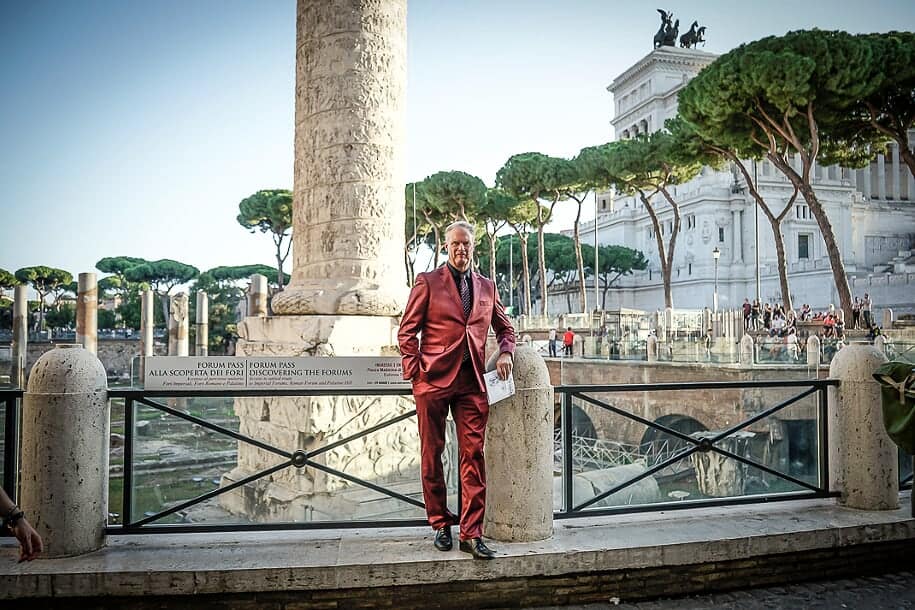
Take the color theme. Marina, who works with the bride’s mother, told me I had to wear red. Huh? Yep. She showed me color swatches that were expected to be honored by all the guests. I happened to own — yes — a red suit. I bought it in a discount warehouse run by a group of guys who look like ex-Camorra hitmen. The Gautieri suit is so shiny I can see my reflection. It looks very Italian.
However, with my ruddy complexion and WASP heritage I look like a flunky for the Irish mob.
I had to shop for a red and black tie that was less flashy than the red, black and purple tie I once wore on Valentine’s Day and repulsed Marina. The man who sold me the new tie talked me out of a new black kerchief I like wearing with this suit.
“It’s only worn at funerals,” he said.
I got off easy. Marina was subject to another odd Italian tradition. In lieu of gifts, guests give the couple 300 euros. It’s smart for the couple. Unlike in the U.S., no Italian bride is stuck with five sets of silverware or three dozen candles. They get enough money for a honeymoon. In this case, it’s a three-pronged adventure to Jordan, Doha and the Maldives. They don’t give away luxury huts over the water in the Maldives.
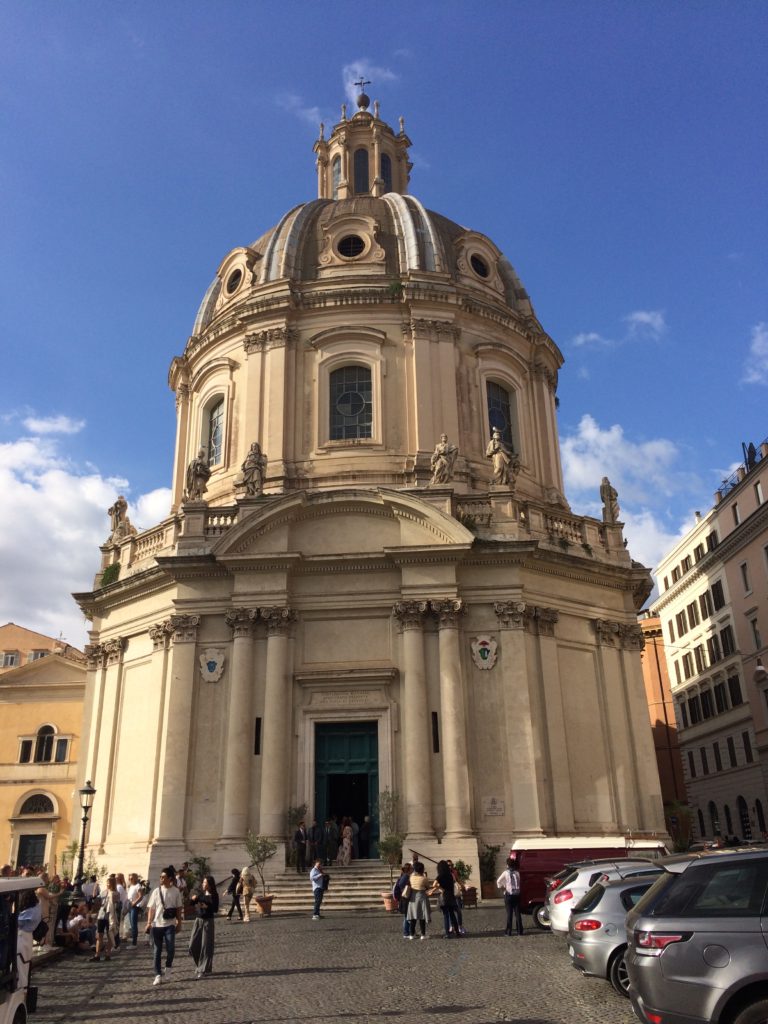
Also, not many American weddings are held in Baroque churches built in 1751. Those that are, the churches don’t feature 18th century paintings decorating six side chapels with marble walls and alabaster stonework. The list of adjectives for Chiesa del Santissimo Nome di Maria al Foro Traiano (The Church of the Most Holy Name of Mary at the Trajan Forum) is as long as its name. In a country with at least 40 percent of the world’s art, with the most beautiful churches in the world, this one still left me slack-jawed.
Also, the neighborhood isn’t bad.
Across the piazza stands Palazzo Venezia sporting the balcony where Mussolini addressed his mob that filled the piazza cheek to cheek. Photos from the 1930s show a dark sea of humanity, looking up at this chubby fascist waving his arms and jutting out his jaw.
Eighty years later, the piazza now fills with Italian-loving tourists. Fans replaced fascists. Nikes replaced jack boots.
It’s also appropriate the church is in the shadow of Il Vittoriano. Besides called Mussolini’s Typewriter, the monument, built in 1885 to honor Italy’s first king, Victor Emmanuel II, it goes by another nickname.
The Wedding Cake.
Hovering over the church steps, just about 50 meters away stands Trajan’s Column. Built in 113 A.D., it’s a 100-foot-high column with intricate carvings depicting Emperor Trajan’s victory in the Dacian Wars.
In a way, the column helped save the church from possible bombing during World War II as fascist archaeologists claimed the Temple of Trajan lay underneath. They were full of shit but generals didn’t know that.
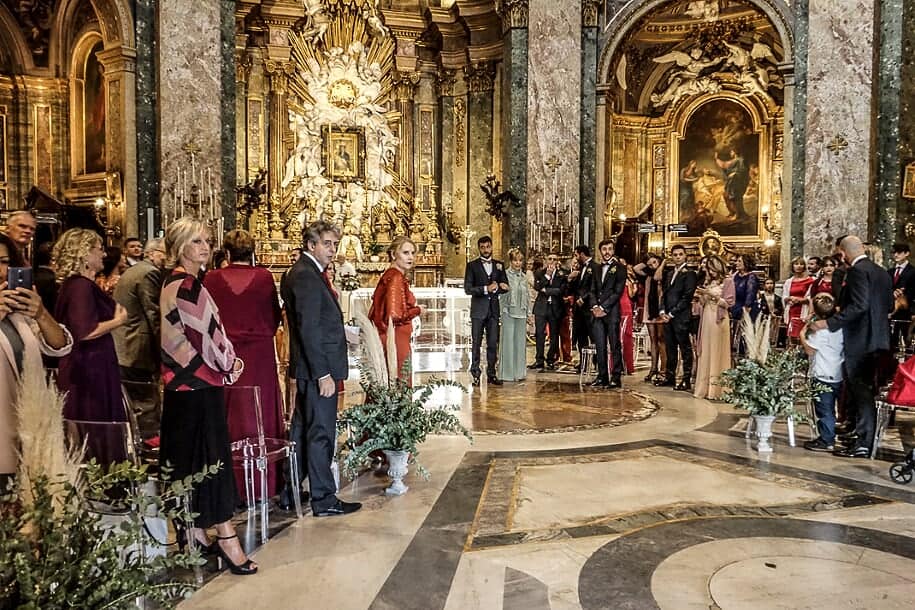
Marina and I arrived at the church by taxi on a typical October day in Rome: sunny and bright blue skies in the mid-70s. Greeting us at the front steps was the groom. Diego is about my height — 6-foot-3 — a giant by Southern Italian standards. With a full head of black hair, a neat beard and dark complexion, he’s so Italian he looked like he came to the church by paddling a gondola up the Tiber.
The inside of any church in Rome is like walking into a museum. When you add a wedding, it’s like walking into someone’s romantic dream. Huge paintings hung in the chapels lining the walls. A massive organ hung 40 feet high over four balconies. A cellist and violinist played classical music as the guests entered.
As the guests filed in, I learned why my favorite line about my bachelorhood always fell flat in Italy. When people ask why I never married, I always say, “Marriage? Ha! I get nervous walking down a movie aisle.”


This church had no aisle. Chairs were fanned out in a circle forming a gaping hole in the middle. Standing next to Diego were only two groomsmen standing off to the side in black tuxedos and magenta ties. One, his brother, kept fixing Guido’s collar.
I noticed one other man in a red suit.
The bride, Monia, dragged a train on her dress that nearly stretched out the door. Our friend and her father, Saverio Morelli, walked her to Diego, marking the start of a 90-minute ceremony. It included a mass, complete with a line to take the wafer (the body of Christ) and scriptures from the Bible.
It also included some personal instructions from the priest, who said he has been conducting weddings for 50 years. He talked about mutual respect and the need for affection and looking after each other. Diego’s mom kept wiping away tears through the ceremony.
A little boy and girl approached bearing the rings as the cellist played “Over the Rainbow.” Thankfully, huge fans behind the guests cooled the church as temperatures outside rose to the high 70s.
The priest never said, “I now pronounce you husband and wife.” After a long discourse in Italian which went way over my head, the couple kissed to loud and applause. And kissed. And kept kissing. After all, this is Italy.
Afterward we all filed out to see a portable cart lining up glasses of Prosecco. As tourists wearing everything from Yankees ball caps to flip-flops filed past us, we raised toasts to each other, to the couple, to Marina and me. Hell, I even raised a toast to a guy walking past me wearing a USC T-shirt. One more glass of Prosecco and I would’ve turned to face Palazzo Venezia and raise a toast to Mussolini’s ghost.
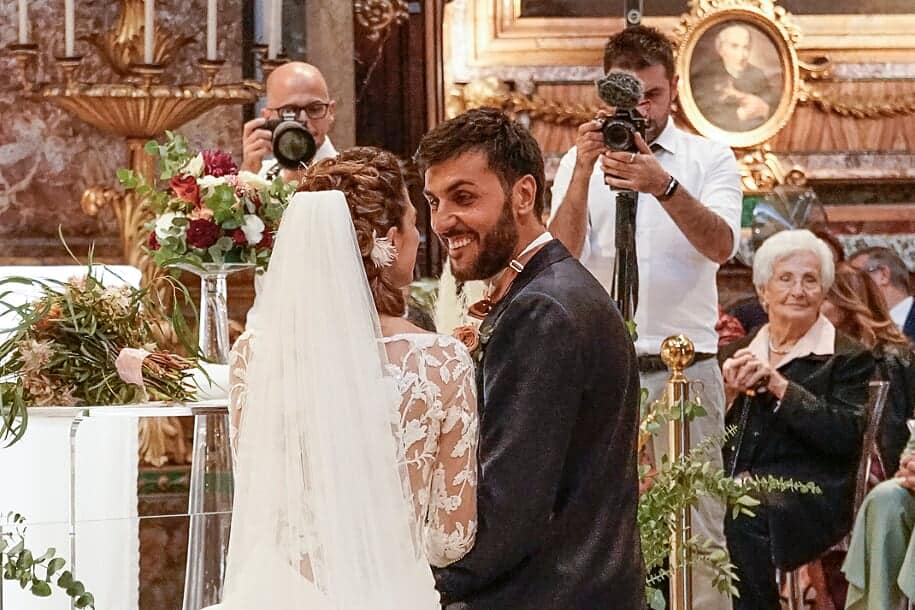
As in the U.S., the wedding is just the antipasti. The meal is the reception. They held Saturday’s at the Casina di Macchia Madama, a sprawling villa high atop Monte Mario with a beautiful view of Rome below. It’s carved inside a forest with a clearing that’s lined with about 40 meters of tables holding antipasti: mini pizzas, cheeses and salamis, couscous, salads, fruits. An open bar was filled with Prosecco bottles, lined up like little sentries.
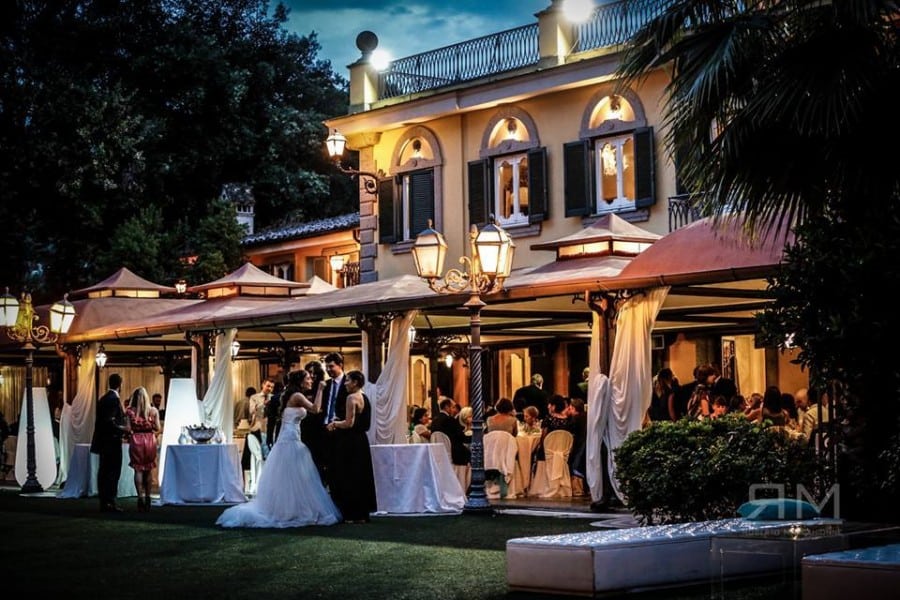
This is a historic spot. During the Middle Ages, Roman emperors encamped in this forest. The villa was built in the early 1900s and owned by the Bourbons of Naples. Restored in 1989, it is almost exclusively used for weddings.
Italian weddings.
I say “Italian weddings” in quote marks because they have become a huge business, particularly for the American audience. Like the Amalfi Coast and wineries in Tuscany, the Italian wedding is part of many Americans’ Italian dream. In fact, according to the website Find Your Italy, wedding tourism in Italy earns 385 million euros a year. More than 24 percent of the clients are from the U.S. Kim Kardashian and Kanye West married in the Fort di Belvedere in Florence. Jessica Biel and Justin Timberlake married in Borgo Egnazia in Puglia. Katie Holmes and Tom Cruise married in the Odescalchi Castle not far from Rome on Lago Bracciano, an event that cost a reported $3 million.
Funny, Italian weddings are very popular for everyone but Italians.

Italians are marrying less frequently than ever before. According to ISTAT, Italy’s statistical arm, Italians married 194,377 times in 2015, the last raw numbers available. That’s down more than 20 percent from the 246,000 married in 2008. In 2017, there were 3.1 marriages for 1,000 people, an all-time low. That’s down nearly 35 percent from the 4.7 in 2012 and more than half of the 8.0 in 1970.
In 1991, 51.5 percent of Italian men aged 25-34 were married. Last year that dropped to 19.1 percent. For women the numbers went from 69.5 to 34.3. Today one quarter of Italian men between 45-54 aren’t married and 18 percent of the women. Divorce has increased four times from 376,000 in 1991 to 1.67 million.
A number of factors have contributed, nearly all economic. Italy remains in its biggest recession since World War II. Employment for Italians 24 and under is at 35 percent. In Europe only Spain and Greece are worse. Emigration is at an all-time high. Italy’s birth rate — it had only eight births of 1,000 inhabitants in 2017 — is the lowest in Europe. Many of the growingly independent Italian women have learned they can have careers and, without children or husbands, they have enough money for those two weeks in Sardinia every August.
Italian men, many of whom still live with their mothers, have become an Italian woman’s accessory, not her necessity.

Regardless of the trend, when Italian weddings do happen they are a highlight of one’s life and not just for the marrying couple. The taxi took Marina and me to the opulent north end of Rome and wound its way up Monte Mario. Olympic Stadium, all lit up in preparation for Italy’s European Championships Qualifying match against Greece that night, stood just below us, its surrounding statues back lit like glowing jewels.
Torches lit the villa’s long, windy driveway and doormen greeted us as we arrived. We took seats at cast-iron tables and looked at this city of Rome below. In the distance we could see Il Vittoriano. On the other end stood St. Peter’s Basilica. Rome’s infamous garbage that I recently wrote about, for now, was nowhere to be seen.
A forest path led to a string of statues and quiet nooks away from the villa’s flood lights. If this place was any more romantic, staff would have to hand out towels.
Dinner was something out of Italian Gourmet magazine. Risotto agli agrumi mantecato al parmigiano con petali di fiori eduli (risotto with creamed citrus fruit, Parmesan cheese and edible flower petals), cavatelli con polipetti, calamari, cicoria piccante e pecorino (short pasta with baby octopus, squid, spicy chicory and pecorino), cosciotto di Chianina al forno e contorni di stagione (baked Italian beef leg and seasonal side dishes) and torta nuziale (wedding cake).
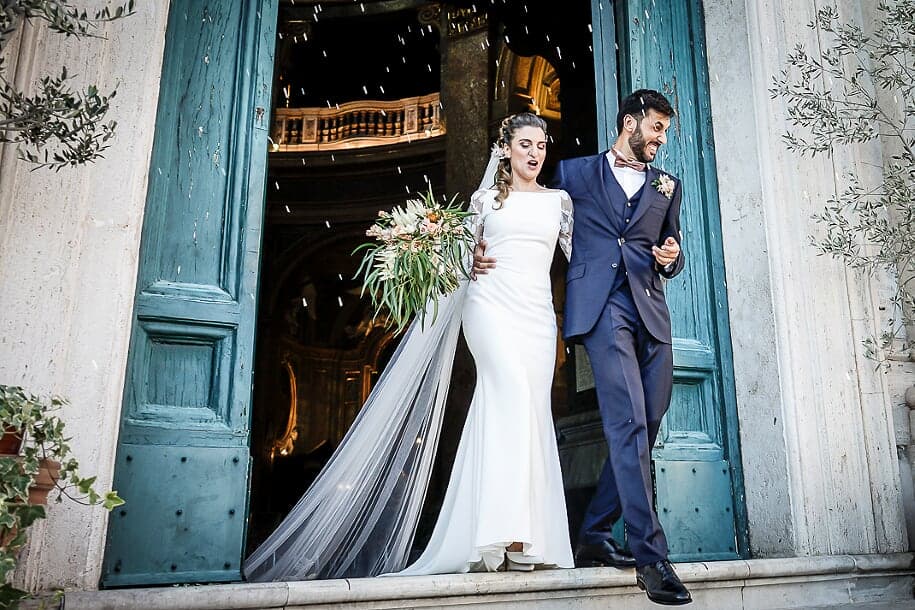
After dinner I bee lined to the open bar where differences between American and Italian weddings were even more stark. The bar was nearly always empty. Romans are famous teetotalers but even when it’s free? Free Prosecco? Good Prosecco? Served by a guy in a suit and tie? In the U.S., half the guests are hammered before the first salad is served.
I camped out at the bar and drank a toxic mixture of Prosecco, Italian Chardonnay and the occasional shot of Grey Goose vodka. Dangerous? A little. Totally immature? No doubt. Pointless?
No.
Dancing was on the agenda and for me to dance, I need to find the right balance between lost inhibitions and inebriation that doesn’t go over the low bar of Italian tolerance. Why? Because the three things in life I hate most are: one, animal abuse; two, war; three, dancing. The one positive I can add is that at least they’re in that order.

A gray-bearded DJ with a Yankees ball cap spun popular Western dance hits from the BeeGees to Michael Jackson and threw in some romantic classics such as “Love is in the Air.” Watching Monia dance with her mom, shimmy to shimmy, made me think back and wonder if my parents ever danced.
Ever.
Between songs, I camped out at a table holding large bowls of “confetti,” small, candy-covered eggs with fillings ranging from strawberry to walnut to chocolate.
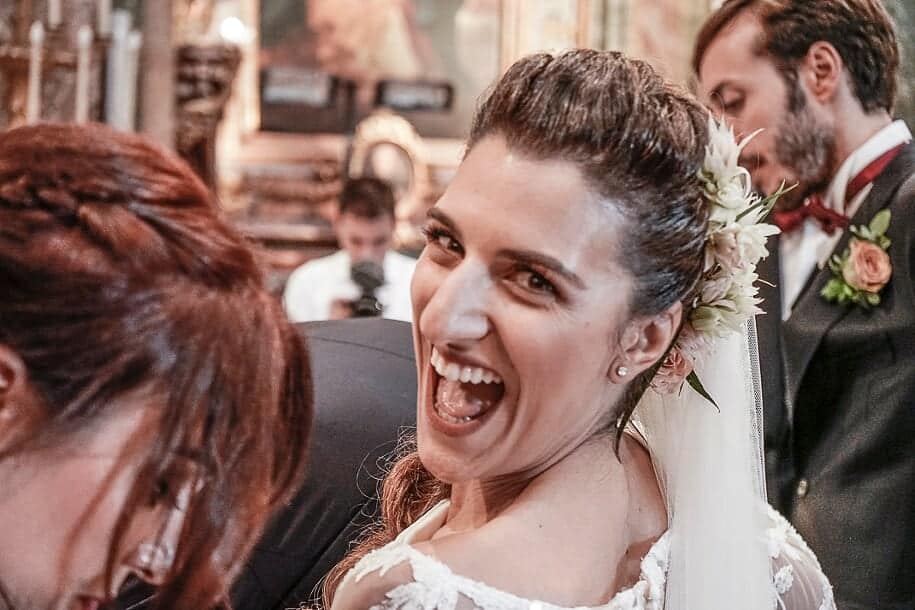
We left at 1 a.m., with the party still going strong and the dance floor hopping. It was a long day, filled with lots of taxis, music and Prosecco. My head was spinning, from the booze, the dancing, the views, the romance. I think Marina’s was, too. If not from the above, maybe from after the wedding.
When we stood outside, looking at the bride and groom covered in rice and heading into a new bright future in the most beautiful city in the world, I told her:
“This will be us some day.”


October 17, 2019 @ 10:33 am
Beautiful in ever aspect and the red suit is flattering. May they have years of happiness.
October 17, 2019 @ 10:33 am
Beautiful in ever aspect and the red suit is flattering. May they have years of happiness.
October 17, 2019 @ 11:37 am
Thanks, Doreen. Notice I put my picture in the distant foreground of more attractive sites such as Trajan’s Column and Il Vittoriano.
October 17, 2019 @ 1:53 pm
Only YOU could look great in a red suit! And I look forward to Italian nuptials between you and your lovely Marina. And of course; the descriptions of Roma beckon me back in one year.
Grazie Mille for the great read! V. Mastroianni
October 17, 2019 @ 1:53 pm
Only YOU could look great in a red suit! And I look forward to Italian nuptials between you and your lovely Marina. And of course; the descriptions of Roma beckon me back in one year.
Grazie Mille for the great read! V. Mastroianni
October 17, 2019 @ 3:58 pm
The red suit looks dashing on you and what a thrill to attend such a beautiful wedding, Marina’s photos are lovely too!
October 17, 2019 @ 4:17 pm
Thanks, Christie. I’ll stop my self loathing then.
October 19, 2019 @ 4:24 am
My, what a nice compliment. That’s my whole goal, to put readers in these places with me. Thank you so much. — John Henderson
January 21, 2020 @ 7:58 am
Great article, I found myself chuckling throughout!
January 22, 2020 @ 2:08 am
Thanks, Delia. It’s hard to make people laugh. I’m glad I at least got a chuckle out of you.